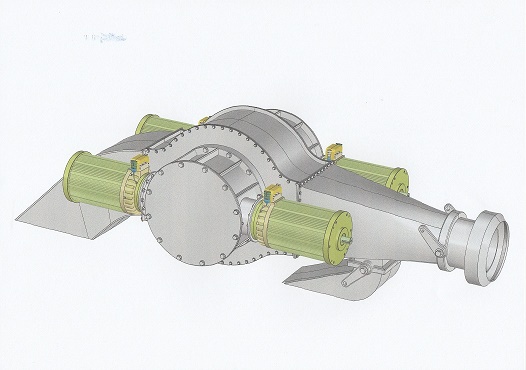


"State of the Art High Performance Water Jet Propulsion"
Starting with the facts about today's so called water jets. Such
water jets are just centrifugal/impeller pumps that accelerate the
water to limited nozzle speed of about 80 knots, (45 m/sec.) With
every knot (0.514 m/sec.) the vessel increases its speed; the nozzle
speed loose this quantity. Meaning, has the vessel reached 40 knots
(20.6 m/sec.), the water jet nozzle speed of 80 knots declined 40
knots, while the vessels resistance increases dramatically. As we
know, the nozzle speed is in this devices limited, and we can only
get more thrust by pumping more water. Mass x Speed is thrust with
reference to the 3rd law of motion by Isaac Newton.
In case we use for more thrust a larger
water jet, the engines have to be also larger, as well as the tanks.
The
vessel
becomes
heavier, the resistance increases, and it is often no more as fast
as before, a difficulty without end.The problem is the restricted
nozzle speed and water flow.
This problem has been solved by the "Grivo Jet Star",
a water jet that works on basic of the patented High Performance
Displacement pump "Grivo Star Pump". The pump works like an infinity
piston in a cylinder. We can easily reach 200 knots (103 m/sec.)
nozzle speed, and have no problem with nozzle speed loss, as above
mentioned. We push just a little the throttle. It is a real Jet. The
limits are material limits, or set by common sense.
Star",
a water jet that works on basic of the patented High Performance
Displacement pump "Grivo Star Pump". The pump works like an infinity
piston in a cylinder. We can easily reach 200 knots (103 m/sec.)
nozzle speed, and have no problem with nozzle speed loss, as above
mentioned. We push just a little the throttle. It is a real Jet. The
limits are material limits, or set by common sense.
The Grivo JetStar is the only real innovation in ship propulsion!
It has
remarkable more performance in comparison with today’s Water Jets,
which represent a system that was invented in the17th Century,
exactly in the year 1660, by Toogood and Hays.